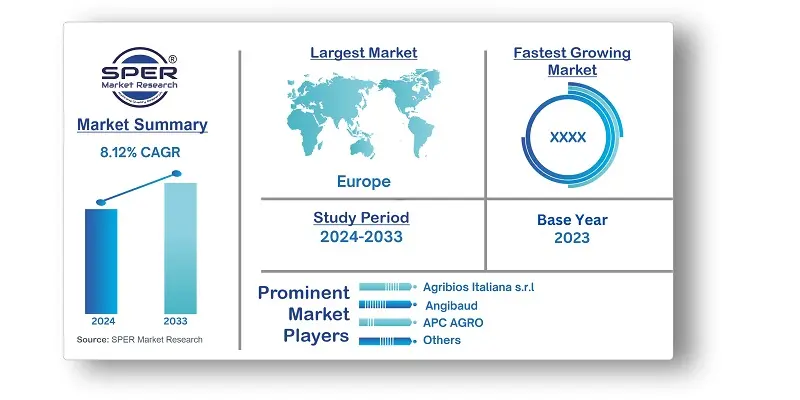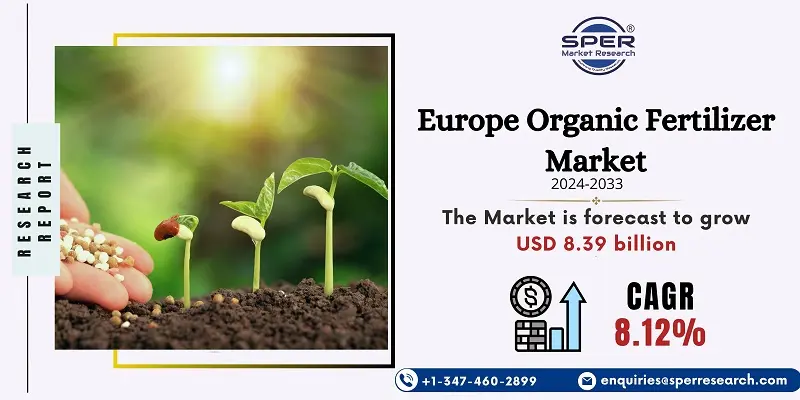
Europe Organic Fertilizer Market Growth, Size, Trends, Demand, Revenue, Share and Future Outlook
Europe Organic Fertilizer Market Size- By Source, By Crop Type, By Form- Regional Outlook, Competitive Strategies and Segment Forecast to 2033
| Published: Mar-2024 | Report ID: AGRI2409 | Pages: 1 - 153 | Formats*: |
| Category : Agriculture | |||
- April 2022: The company approved and the merger of two wholly-owned subsidiaries, Liberty Pesticides and Fertilizers Limited (LPFL) and Coromandel SQM (India) Private Limited (CSQM), became effective on April 1, 2021. Over time, it's anticipated that this merger will expand the business's offerings, which will include its organic fertilizers.
- A bio-enriched organic manure called "Godavari BhuBhagya" was introduced by the company in May 2021.


| Report Metric | Details |
| Market size available for years | 2020-2033 |
| Base year considered | 2023 |
| Forecast period | 2024-2033 |
| Segments covered | By Source, By Crop Type, By Form |
| Regions covered | Germany, France, Italy, Spain, UK, Rest of Europe |
| Companies Covered | Agribios Italiana s.r.l., Angibaud, APC AGRO, Coromandel International Ltd., Fertikal NV, HELLO NATURE ITALIA srl, Indogulf BioAg LLC (Biotech Division of Indogulf Company), ORGANAZOTO FERTILIZZANTI SPA, Plantin, Suståne Natural Fertilizer Inc., Others |
- Agricultural Industry Professionals
- Environmentalists and Conservationists
- Organic Farming Enthusiasts
- Home Gardeners and Urban Agriculturists
- Sustainable Agriculture Advocates
- Health-Conscious Consumers
| By Source: |
|
| By Crop Type: |
|
| By Form: |
|
- Europe Organic Fertilizer Market Size (FY’2024-FY’2033)
- Overview of Europe Organic Fertilizer Market
- Segmentation of Europe Organic Fertilizer Market By Source (Plant, Animal, Mineral)
- Segmentation of Europe Organic Fertilizer Market By Crop Type (Cereal & Grain, Oilseed & Pulse, Fruits & Vegetables, Others)
- Segmentation of Europe Organic Fertilizer Market By Form (Dry, Liquid)
- Expansion Analysis of Europe Organic Fertilizer Market
- Problems and Obstacles in Europe Organic Fertilizer Market
- Competitive Landscape in the Europe Organic Fertilizer Market
- Impact of COVID-19 and Demonetization on Europe Organic Fertilizer Market
- Details on Current Investment in Europe Organic Fertilizer Market
- Competitive Analysis of Europe Organic Fertilizer Market
- Prominent Players in the Europe Organic Fertilizer Market
- SWOT Analysis of Europe Organic Fertilizer Market
- Europe Organic Fertilizer Market Future Outlook and Projections (FY’2024-FY’2033)
- Recommendations from Analyst
1.1. Scope of the report1.2. Market segment analysis
2.1. Research data source2.1.1. Secondary Data2.1.2. Primary Data2.1.3. SPER’s internal database2.1.4. Premium insight from KOL’s2.2. Market size estimation2.2.1. Top-down and Bottom-up approach2.3. Data triangulation
4.1. Driver, Restraint, Opportunity and Challenges analysis4.1.1. Drivers4.1.2. Restraints4.1.3. Opportunities4.1.4. Challenges4.2. COVID-19 Impacts of the Europe Organic Fertilizer Market
5.1. SWOT Analysis5.1.1. Strengths5.1.2. Weaknesses5.1.3. Opportunities5.1.4. Threats5.2. PESTEL Analysis5.2.1. Political Landscape5.2.2. Economic Landscape5.2.3. Social Landscape5.2.4. Technological Landscape5.2.5. Environmental Landscape5.2.6. Legal Landscape5.3. PORTER’s Five Forces5.3.1. Bargaining power of suppliers5.3.2. Bargaining power of buyers5.3.3. Threat of Substitute5.3.4. Threat of new entrant5.3.5. Competitive rivalry5.4. Heat Map Analysis
6.1. Europe Organic Fertilizer Market Manufacturing Base Distribution, Sales Area, Product Type6.2. Mergers & Acquisitions, Partnerships, Product Launch, and Collaboration in Europe Organic Fertilizer Market
7.1. Europe Organic Fertilizer Market Value Share and Forecast, By Source, 2024-20337.2. Plant7.3. Animal7.3.1. Manure7.3.2. Others7.4. Mineral
8.1. Europe Organic Fertilizer Market Value Share and Forecast, By Crop Type, 2024-20338.2. Cereal & Grain8.3. Oilseed & Pulse8.4. Fruit & Vegetables8.5. Others
9.1. Europe Organic Fertilizer Market Value Share and Forecast, By Form, 2024-20339.2. Dry9.3. Liquid
10.1. Europe Organic Fertilizer Market Size and Market Share
11.1. Europe Organic Fertilizer Market Size and Market Share By Source (2020-2026)11.2. Europe Organic Fertilizer Market Size and Market Share By Source (2027-2033)
12.1. Europe Organic Fertilizer Market Size and Market Share By Crop Type (2020-2026)12.2. Europe Organic Fertilizer Market Size and Market Share By Crop Type (2027-2033)
13.1. Europe Organic Fertilizer Market Size and Market Share By Form (2020-2026)13.2. Europe Organic Fertilizer Market Size and Market Share By Form (2027-2033)
14.1. Europe Organic Fertilizer Market Size and Market Share By Region (2020-2026)14.2. Europe Organic Fertilizer Market Size and Market Share By Region (2027-2033)14.3. Germany14.4. France14.5. Italy14.6. Spain14.7. UK14.8. Rest of Europe
15.1. Agribios Italiana s.r.l.15.1.1. Company details15.1.2. Financial outlook15.1.3. Product summary15.1.4. Recent developments15.2. Angibaud15.2.1. Company details15.2.2. Financial outlook15.2.3. Product summary15.2.4. Recent developments15.3. APC AGRO15.3.1. Company details15.3.2. Financial outlook15.3.3. Product summary15.3.4. Recent developments15.4. Coromandel International Ltd.15.4.1. Company details15.4.2. Financial outlook15.4.3. Product summary15.4.4. Recent developments15.5. Fertikal NV15.5.1. Company details15.5.2. Financial outlook15.5.3. Product summary15.5.4. Recent developments15.6. HELLO NATURE ITALIA srl15.6.1. Company details15.6.2. Financial outlook15.6.3. Product summary15.6.4. Recent developments15.7. Indogulf BioAg LLC (Biotech Division of Indogulf Company)15.7.1. Company details15.7.2. Financial outlook15.7.3. Product summary15.7.4. Recent developments15.8. ORGANAZOTO FERTILIZZANTI SPA15.8.1. Company details15.8.2. Financial outlook15.8.3. Product summary15.8.4. Recent developments15.9. Plantin15.9.1. Company details15.9.2. Financial outlook15.9.3. Product summary15.9.4. Recent developments15.10. Suståne Natural Fertilizer Inc.15.10.1. Company details15.10.2. Financial outlook15.10.3. Product summary15.10.4. Recent developments15.11. Others
SPER Market Research’s methodology uses great emphasis on primary research to ensure that the market intelligence insights are up to date, reliable and accurate. Primary interviews are done with players involved in each phase of a supply chain to analyze the market forecasting. The secondary research method is used to help you fully understand how the future markets and the spending patterns look likes.
The report is based on in-depth qualitative and quantitative analysis of the Product Market. The quantitative analysis involves the application of various projection and sampling techniques. The qualitative analysis involves primary interviews, surveys, and vendor briefings. The data gathered as a result of these processes are validated through experts opinion. Our research methodology entails an ideal mixture of primary and secondary initiatives.



Frequently Asked Questions About This Report
PLACE AN ORDER
Year End Discount
Sample Report
Pre-Purchase Inquiry
NEED CUSTOMIZATION?
Request CustomizationCALL OR EMAIL US
100% Secure Payment






Related Reports
Our Global Clients
Our data-driven insights have influenced the strategy of 200+ reputed companies across the globe.




















